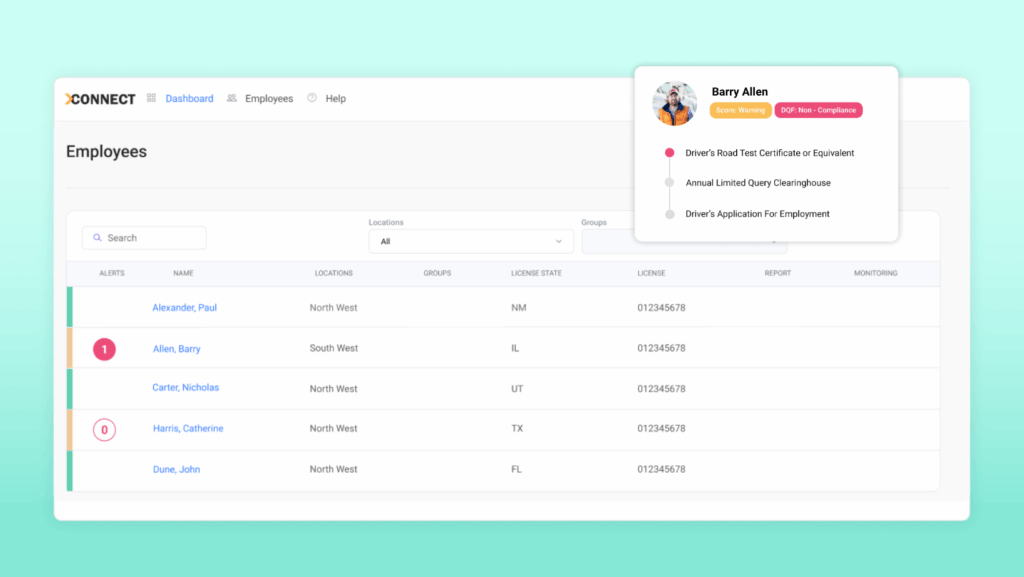Fleet Audit: How to Perform One? (Step-by-Step)

Valeria Ycaza I 5 min reading I September 30, 2025
Every year, roadside inspections uncover serious compliance gaps in fleets. In 2024 alone, inspectors placed 23% of vehicles and nearly 5% of drivers out of service due to violations ranging from bad brakes to missing medical certificates (CVSA).
A fleet audit is your best defense. By reviewing driver files, vehicle maintenance, and compliance records, you can catch problems before inspectors or accidents do. Keep reading for a step-by-step fleet audit checklist to help you stay ahead.
What is a Fleet Audit?
A fleet audit is a structured review of a company’s vehicle operations, safety compliance, and management practices. Its goal is to ensure that the fleet meets regulatory requirements, operates safely, and runs cost-efficiently.
✅ Think of it as a health checkup for your fleet that can help reduce risks like accidents, breakdowns, and unnecessary expenses.
How to Perform a Fleet Audit
Every fleet looks a little different, which means there’s no single “right way” to conduct an audit. This checklist breaks down the audit into clear, actionable steps, allowing you to prepare your records, identify risks, and create an improvement plan.
Step 1: Define the Scope
Before you begin, set clear boundaries for what your audit will cover. Audits can be broad, covering your entire fleet operation, or narrow, focusing only on safety or compliance. Here are some examples of different scopes of audits:
Safety audits: Driver behavior, driving records, accident history, training records.
Compliance audits: DOT/OSHA requirements, driver qualification files, hours-of-service.
Financials audits: Fuel efficiency, leasing vs. owning costs, insurance claims.
Vehicle audits: Preventive maintenance schedules, parts replacement, downtime.
Step 2: Gather Documentation
Fleet audits are built from your own data. Accurate, up-to-date records give you the full picture of how your fleet is performing and where risks may be hiding. To prepare properly, make sure you collect:
Driver Files
• Valid licenses and endorsements for every driver.
• Motor Vehicle Records (MVRs) showing recent violations or suspensions.
• Training records, including defensive driving courses, safety refreshers, or CDL upgrades.
• DQ files, background checks, and medical certifications (DOT physicals).
Vehicle Records
• Maintenance logs with dates of service, repairs, and preventative work.
• Daily inspection reports (DVIRs) and annual DOT inspections.
• Odometer readings and mileage tracking.
Telematics Reports
• GPS tracking data for routes, stops, and delivery times.
• Safety metrics such as speeding, harsh braking, and sharp turns.
• Idling and fuel consumption reports.
Fuel & Expense Data
• Fuel receipts matched against mileage for efficiency.
• Expense reports related to tolls, parking, or repairs.
• Patterns that could suggest fraud or fuel misuse.
Incident & Safety Reports
• Accident and near-miss reports.
• Insurance claim records and settlements.
• DOT citations and CSA Score reports.
Step 3: Analyze Data and Spot Gaps
Once you’ve gathered the records, the next step is turning raw information into insights. This is where the real value of a fleet audit comes in. Data analysis helps you uncover hidden risks, inefficiencies, and opportunities for improvement. Start by asking questions such as:
- Are drivers are accumulating new MVR violations or citations?
- Any repeated patterns of unsafe behavior like speeding, harsh braking, or distracted driving?
- Do certain vehicles show recurring maintenance issues?
- Are collisions more frequent during specifc shifts, routes, or seasons?
- Is fuel consumption higher than expected?
- Are any driver qualification files incomplete or out of date?
Step 4: Create a Corrective Action Plan
An audit is only useful if it drives change. When creating a corrective action plan, start by prioritizing issues in order of risk, focusing first on safety concerns or compliance violations that could lead to fines or accidents. Next, assign responsibility so each task has a clear owner, whether that’s a driver supervisor, maintenance team, or safety officer.
Be sure to set timelines for every action, distinguishing between immediate fixes, such as renewing expired licenses, short-term actions such as driver training, and long-term initiatives like upgrading to a driver management software. Finally, track progress by scheduling regular follow-ups.
Avoid Common Mistakes in Fleet Audits
Not performing One at All
Surprisingly, some fleets skip audits entirely until they’re forced into a DOT audit or face an incident. In 2023, 94% of DOT audits uncovered at least one violation. Without regular audits, blind spots grow, leading to increased risks, fines, and costs that could have been prevented.
Incomplete Documentation
Many fleet audits fail because records are missing, inconsistent, or outdated. This not only slows down the process but can also put your company at risk of non-compliance. Many companies still rely on manual or paper-based file processes increasing the risk of incomplete reports.

💡Use a digital safety system to centralize fleet data, access real-time insights, and automate record-keeping.
Failing to Act on Findings
The biggest mistake is conducting the audit, creating a report, and then letting it sit on a shelf. An audit should always lead to action. Translate findings into an actionable improvement plan with assigned owners, clear timelines, and measurable goals. Without follow-up, even the best audit is wasted effort.
Simplify Audits With the Right Technology
A fleet audit shouldn’t feel overwhelming. With the right systems in place, it becomes a continuous process of improvement rather than a one-time fire drill. Embark Safety equips fleet and safety managers with the tools to stay compliant, improve safety, and reduce risk. Learn more about our solutions: MVR Monitoring, DQF Manager, CSA Monitoring, Driver Training, and more.
FAQs About Fleet Audits
At least once per year, but quarterly reviews could give fleets more room for corrective actions and improvement.
A DOT audit is government-mandated, while a fleet audit is internal and proactive, helping you prepare for official inspections.
Usually the fleet manager or compliance officer, but many companies hire third-party audit services for accuracy and expertise.
*We are not lawyers. Consult with your legal counsel to ensure your processes and procedures meet/ or exceed safety standards and compliance regulations. Please read our legal disclaimer.






